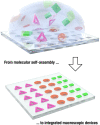DNA Origami Meets Bottom-Up Nanopatterning
- PMID: 34255962
- PMCID: PMC8320526
- DOI: 10.1021/acsnano.1c04297
DNA Origami Meets Bottom-Up Nanopatterning
Abstract
DNA origami has emerged as a powerful molecular breadboard with nanometer resolution that can integrate the world of bottom-up (bio)chemistry with large-scale, macroscopic devices created by top-down lithography. Substituting the top-down patterning with self-assembled colloidal nanoparticles now takes the manufacturing complexity of top-down lithography out of the equation. As a result, the deterministic positioning of single molecules or nanoscale objects on macroscopic arrays is benchtop ready and easily accessible.
Conflict of interest statement
The authors declare no competing financial interest.
Figures





References
-
- Watson G. S.; Green D. W.; Cribb B. W.; Brown C. L.; Meritt C. R.; Tobin M. J.; Vongsvivut J.; Sun M.; Liang A.-P.; Watson J. A. Insect Analogue to the Lotus Leaf: A Planthopper Wing Membrane Incorporating a Low-Adhesion, Nonwetting, Superhydrophobic, Bactericidal, and Biocompatible Surface. ACS Appl. Mater. Interfaces 2017, 9, 24381–24392. 10.1021/acsami.7b08368. - DOI - PubMed
-
- Kershner R. J.; Bozano L. D.; Micheel C. M.; Hung A. M.; Fornof A. R.; Cha J. N.; Rettner C. T.; Bersani M.; Frommer J.; Rothemund P. W. K.; Wallraff G. M. Placement and Orientation of Individual DNA Shapes on Lithographically Patterned Surfaces. Nat. Nanotechnol. 2009, 4, 557–561. 10.1038/nnano.2009.220. - DOI - PubMed
Publication types
MeSH terms
Substances
LinkOut - more resources
Full Text Sources
Research Materials

